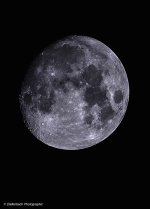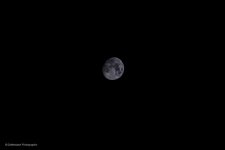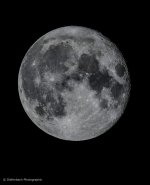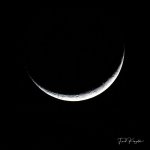You are using an out of date browser. It may not display this or other websites correctly.
You should upgrade or use an alternative browser.
You should upgrade or use an alternative browser.
So what lens to shoot the moon?
- Thread starter EODK9Trainer
- Start date
This photo of the moon was taken within a few days of when my new Z50 camera had arrived.
It was taken, handheld on manual, With kit lens (50-250) iso 100. I then previewed the image while tweaking the shutter (above 1/250s) to determine how dark or bright to make it. f/6.3: 1/320s: ISO: 100
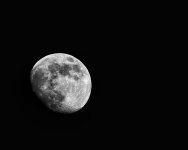
It was taken, handheld on manual, With kit lens (50-250) iso 100. I then previewed the image while tweaking the shutter (above 1/250s) to determine how dark or bright to make it. f/6.3: 1/320s: ISO: 100

Last edited:
Bikerbrent_RIP
Senior Member
Welcome aboard rrgramps. Enjoy the ride.
We look forward to seeing more posts and samples of your work.
Your moon shot is nice!
We look forward to seeing more posts and samples of your work.
Your moon shot is nice!
BF Hammer
Senior Member
I have taken photos of the moon with various lenses over 12 years. I've used a 70-300mm, which was my longest zoom lens for nearly a decade. I bought a Nikkor 500mm reflex lens from the 1970s and used that for a while. I found both of those lenses a bit soft for this work. I use a Sigma 150-600mm C lens now for moon and really most astrophotography subjects.
Photo below is about 54 images stacked (RegiStax). Taken February, 2020. D750 with Sigma 150-600mm, shot from a SkyWatcher AZ-GTi goto tracking mount and it's stock tripod. I've had poor full-moon images from all prior attempts, but this one worked.
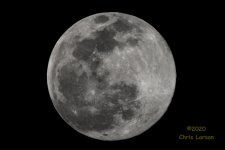
Looking back to 2018, I found a series where I tried comparing the Nikkor 500mm reflex to the Sigma 150-600mm C directly. I even limited the Sigma to 500mm when I took the photos. These are single exposure images, no stacking. It also is before the tracking mount, taken on a tripod.
500mm reflex
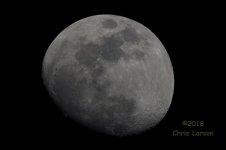
Sigma at 500mm
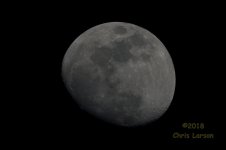
Photo below is about 54 images stacked (RegiStax). Taken February, 2020. D750 with Sigma 150-600mm, shot from a SkyWatcher AZ-GTi goto tracking mount and it's stock tripod. I've had poor full-moon images from all prior attempts, but this one worked.

Looking back to 2018, I found a series where I tried comparing the Nikkor 500mm reflex to the Sigma 150-600mm C directly. I even limited the Sigma to 500mm when I took the photos. These are single exposure images, no stacking. It also is before the tracking mount, taken on a tripod.
500mm reflex

Sigma at 500mm

Last edited:
mrcoomes59
Senior Member
Hi, I was looking through this thread and always liked this image. How do you process the moon to get so much color in it? I have seen a hint of color in mine, but nothing like this.
Mainly just boosting the saturation and vibrancy
Sent from my iPhone using Tapatalk
BF Hammer
Senior Member
I did some experimenting this past Saturday night when the Moon and Mars were converged together. I had my 1970's Nikkor 500mm f/8 reflex lens mounted to my D7000 and Sigma 150-600mm f/5-6.3 C mounted to my D750. I used my SkyWatcher AZ-GTi goto mount and tripod as the base. Both of the cameras were controlled remotely by DigiCamControl software. I particularly wanted to use the software so I could see LiveView on my laptop PC display, and I also used the astrophotography focus tools to dial in the focus as close to perfect as I could. Focus adjustment easily was my best job to date using this method (and I will continue using this method for astrophotography).
I post-processed a single Raw image from each setup using Luminar 4. I tried to bring out the most detail of the moon as I could and boost the apparent brightness of Mars as the goal. The D7000+500mm reflex lens image did get a small amount of noise reduction filter (knowing it would detract from any sharp filter I applied) but the D750 image did not need this. I will admit, the full size images in Luminar have more sharpness. The D750 image lost a lot in the conversion down in size and into a JPG. D7000 image not as much loss, but lost a bit anyhow.
D750 + Sigma 150-600mm f/5-6.3 C lens ISO=200 S=1/320 A=f/8
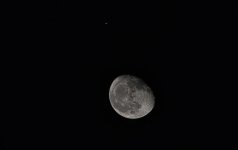
D7000 + Nikkor 500mm f/8 reflex lens ISO=160 S=1/200 A=f/8
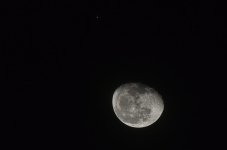
Really in Luminar the Sigma is waaaaay better all-around. But the reflex lens is acceptable considering the purchase price. Put it on the D750 and it should have less noise and won't need to intentionally detract the sharpness there.
I post-processed a single Raw image from each setup using Luminar 4. I tried to bring out the most detail of the moon as I could and boost the apparent brightness of Mars as the goal. The D7000+500mm reflex lens image did get a small amount of noise reduction filter (knowing it would detract from any sharp filter I applied) but the D750 image did not need this. I will admit, the full size images in Luminar have more sharpness. The D750 image lost a lot in the conversion down in size and into a JPG. D7000 image not as much loss, but lost a bit anyhow.
D750 + Sigma 150-600mm f/5-6.3 C lens ISO=200 S=1/320 A=f/8

D7000 + Nikkor 500mm f/8 reflex lens ISO=160 S=1/200 A=f/8

Really in Luminar the Sigma is waaaaay better all-around. But the reflex lens is acceptable considering the purchase price. Put it on the D750 and it should have less noise and won't need to intentionally detract the sharpness there.
The "go-to" camera/lens rig I have used for a long time is a D500 (which I use for the crop factor), 600mm f/4 ED-IF AIS Nikkor with Nikon TC-300 2x teleconverter. Including the crop factor, the total magnification is 36x (over full frame). A very sturdy tripod is a must and either a corded or wireless remote release is strongly recommended. Wireless remotes are not expensive, I use one made by YouPro and it was around $22 on Ebay. If you don't have one you can always use the self timer. For support I use a Bogen 3040 tripod I got over 20 years ago. It is a BEAST of a tripod at about 15 pounds including the head, but it is also rock solid. It is a very good idea to use Live View when shooting the moon. This is for a couple of reasons, focusing is easier as you can increase the magnification on the screen (my 600mm focuses past infinity as there are ED elements in it) and your mirror is already up so you will not get vibrations (and therefore loss in sharpness) when the mirror goes up.
I took this photo of a waxing gibbous moon last night with the above rig right off the back deck. The image is essentially uncropped.
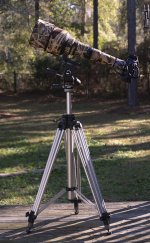
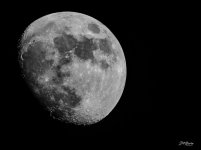
I took this photo of a waxing gibbous moon last night with the above rig right off the back deck. The image is essentially uncropped.



